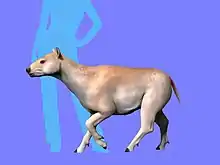| Carolodarwinia | |
|---|---|
| Scientific classification | |
| Domain: | Eukaryota |
| Kingdom: | Animalia |
| Phylum: | Chordata |
| Class: | Mammalia |
| Order: | †Notoungulata |
| Genus: | †Archaeogaia Ameghino, 1901 |
| Type species | |
| Carolodarwinia pyramidentata Ameghino, 1901 | |
Carolodarwinia is an extinct genus of indeterminate Notoungulate, who lived during the Mustersan stage of the Eocene in what is today Argentina. Its fossilized remains have been found near the Lake Colhué Huapí.
History
Carolodarwinia was first described in 1901 by Florentino Ameghino, based on M.A.C.N. No. 10900, a right upper posterior premolar found in the Couches à Astraponotus, near what is today the Lake Colhué Huapí in Argentine Patagonia.[1] Ameghino associated with this unique premolar several canines, now presumably lost.[2] He considered the genus as belonging to the family Leontiniidae, and as a direct ancestor of the genus Leontinia.[1] More recently, in 1967, George Gaylord Simpson acknowledged the loss of the fossilized canines, and preferred recovering as Notoungulata incertae sedis, based on the fragmentary and almost dubious status of the genus, on its dating and on slight differences between the premolar of the genus and those of later leontiniids.[2]
References
- 1 2 Ameghino, F. (1901). "Notices préliminaires sur des ongulés nouveaux des terrains crétacés de Patagonie". Boletin de la Academia Nacional de Ciencias de Córdoba (in French). 16: 349–429.
- 1 2 Simpson, G.L. (1967). "The beginning of the Age of Mammals in South America, part 2". Bulletin of the American Museum of Natural History. 137: 1–260.




.jpg.webp)



